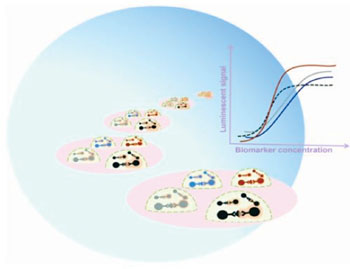Aqueous Two-Phase Systems Enable Homogeneous Immunoassay Multiplexing
By LabMedica International staff writers
Posted on 28 Jul 2014
A novel test simplifies disease detection by enabling simultaneous detection of multiple proteins in blood plasma in only two hours.Posted on 28 Jul 2014
The test can accurately and simultaneously measure multiple biomarker proteins that indicate the presence of diseases like graft-versus-host disease as happens in bone marrow transplant rejection and needs no washing steps, and uses only a minute volume of blood plasma.

Image: Multiphase polymer systems confine unique antibody-conjugated beads that bind with high sensitivity and specificity to plasma protein biomarkers, eliciting amplified luminescent signals. The signal intensity from the beads is proportional to the levels of disease biomarkers in the blood plasma (Photo courtesy of World Scientific).
Scientists at the University of Michigan (Ann Arbor, MI, USA) developed the protein test, which uses a micropatterning method. To perform the assay, a few microliters of blood plasma is mixed with poly(ethylene glycol) and added to a microwell in a custom 384-well microplate. Next, microdroplets of dextran, containing complimentary pairs of antibody-beads, are dispensed into microbasins within the sample well. During two-hour incubation, target plasma protein biomarkers diffuse from the poly(ethylene glycol) phase to the dextran droplets and become sandwiched by the antibody beads. The microplate is then read on a commercially available plate reader.
The cross-reaction-free, multiplex assay can simultaneously detect picomolar concentrations of four protein biomarkers: C-X-C motif ligand 10 (CXCL10), CXCL9, interleukin (IL)-8 and IL-6 in cell supernatants using a single assay well. The potential clinical utility of the assay was demonstrated by detecting diagnostic biomarkers (CXCL10 and CXCL9) in plasma from 88 patients at the onset of the clinical symptoms of chronic graft-versus-host disease (GVHD).
Shuichi Takayama, PhD, a professor and a senior author of the study, said, “Just as oil and water remain immiscible, we use two aqueous solutions that do not mix with each other. Interestingly, these solutions can be patterned into arrays, whereas standard no-wash protein test reagents normally just mix together in solution. This novel capability makes it possible, for the first time, to measure multiple diagnostic proteins at a time in a no-wash format test.”
Arlyne Simon, PhD, the lead author of the study, said, “We envision that our user-friendly and highly accurate platform will be widely used by academic and clinical scientists for diagnostics as well as other applications. To ease the adoption of our technology into research and clinical labs, we designed custom microplates that can be analyzed by commercially available plate readers.” The study was published on June 2, 2014, in the journal TECHNOLOGY.
Related Links:
University of Michigan




 assay.jpg)









